Remember only being able to send 1,000 texts each month?
My mom definitely remembers our phone bills when I doubled that amount every week in middle school.
Thankfully, companies created messaging apps to provide free and unlimited messaging, which was a refreshing solution for rigid text message limits and their lofty costs.
But messaging apps refused to be just another form of text messaging. They kept innovating and evolved into apps for almost every digital interaction possible.
Now, within a single app, you can chat with your friends, communicate with brands, make calls, play games, consume content, buy products, and even call a cab.
These added functionalities make messaging apps sticky. They draw users to the app more often and keep them there for a longer time. Today, messaging apps have over 5 billion monthly active users worldwide.
Most messaging apps also let businesses market to their massive, engaged user bases. Marketers can now use chatbots to provide customer service, send content to users, sell products, and advertise.
Naturally, different countries and age groups prefer some apps to others. Read on to learn how you can tailor your messaging app marketing for five different global messaging apps.
5 Best Messaging Apps for Marketing in 2017
1) WhatsApp
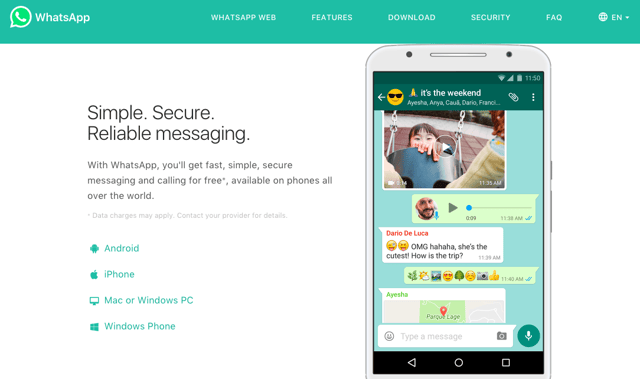
Monthly active users:1.3 billion
Most Popular Regions: Latin America, Europe, The Middle East, Southeast Asia, India, Russia, and Africa
Age Group: 25-44
Marketing Features:
WhatsApp doesn’t sell ads, prohibits third-party bots, and limits its broadcast message feature and group chats to 256 people. How are marketers supposed to leverage the most popular messaging app in the world then?
Since WhatsApp isn’t conducive to large-scale content distribution, marketers must take advantage of its one-to-one messaging capabilities. And by interacting with WhatsApp users like a normal user would, marketers can execute hyper-targeted and personalized campaigns.
In 2014, Hellman’s Brazil created WhatsCook, a live recipe service that connected people to real chefs. This wasn’t a service that just recommended recipes, though. It created recipes with the ingredients users already had.
After signing up for the service on their website, users would send a picture of their refrigerator's contents to WhatsCook. Then a chef would whip up a unique recipe using the person’s available ingredients and teach them how to cook it using pictures, videos, and other WhatsApp features.
Over 13,000 people people signed up for WhatsCook and each user spent an average of 65 minutes interacting with Hellman’s chefs. The service also received a 99.5% approval rating.
WhatsCook is a prime example of creative WhatsApp marketing. By attracting users with a helpful service, they engaged thousands of more people than they could by blasting content through a broadcast or group chat.
To start a service like WhatsCook, you just need users’ phone numbers or they can add your number to their contact list.
Fortunately, WhatsApp offers a click-to-chat link that you can embed in your website, email signature, or social profiles, allowing you to effectively promote your service.
2) Facebook Messenger
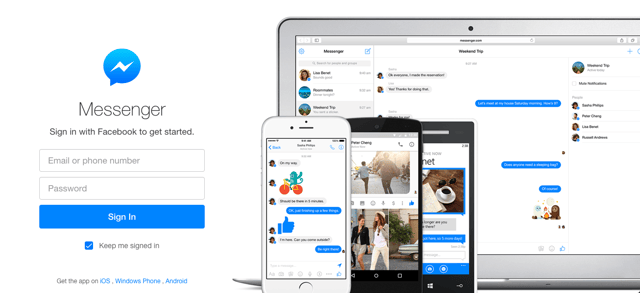
Monthly active users: 1.2 billion
Most Popular Regions: North America, Europe, Australia, The Middle East, South Asia, Southeast Asia, and Africa
Age group: 16-44
Marketing Features:
Facebook messenger offers brands a stockpile of marketing features.
For instance, you can serve destination ads in people’s newsfeed to drive them to your messenger and spark a conversation, send sponsored messages to people who’ve messaged you in the past, integrate messenger bots like Chatfuel and ManyChat to interact with customers, and more.
At HubSpot, we use chatbots to automate Facebook conversations with people. Whenever someone messages our Facebook account, our chatbot will message back with a menu of options.
People can then search and subscribe to our content, check out our software, look at job openings, ask for customer support, and manage their Facebook messenger blog subscription.
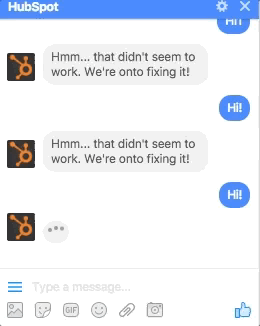
3) WeChat
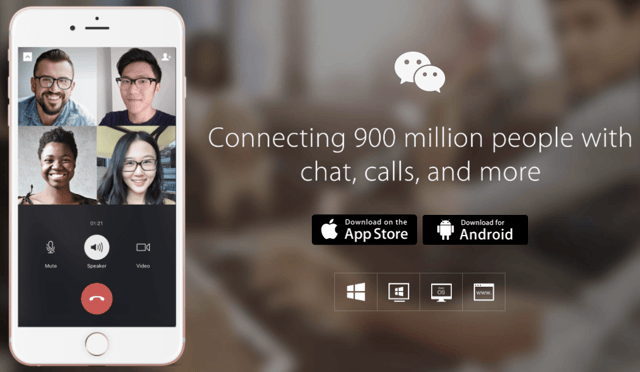
Monthly active users: 938 million
Most popular regions: China
Age Group: 18-50
Marketing Features:
WeChat isn’t just a popular Chinese messaging app. Most Chinese citizens use it to run their entire lives.
In one app, they can:
- Message friends
- Post social updates in WeChat Moments
- Read the news
- Make in-store payments
- Pay for bills
- Transfer money
- Shop online
- Play games
- Make voice and video calls
- Book a taxi
- And manage their personal finances
WeChat is China’s most popular messaging app for a reason. And it also provides marketers a lot of opportunity to engage and delight users.
But if you want to market to users in China, or 90% of the user base, your business must be registered in Mainland China.
Businesses based in the United States, Hong Kong, India, Indonesia, Macau, Malaysia, South Africa, Taiwan, and Thailand can only market to around 100 million of WeChat’s international users.
To establish a strong presence on WeChat, you should set up an official account for your business. This will allow you to create a company micro-site, publish content, and provide customer services all within the WeChat app.
There are two types of official accounts. Content publishers usually sign up for subscription accounts that let you broadcast one message per day to your subscribers in their subscription accounts folder.
Big retail chains usually sign up for service accounts that let you broadcast four messages per month to your subscribers in their friend session list.
Verified service accounts have access to 9 advanced APIs and WeChat payment. With access to these APIs, marketers can:
- Leverage personalized content marketing, location-based marketing, influencer marketing, and QR code marketing
- Open micro-stores
- And run lotteries
All accounts also offer bots that can interact with users and deliver keyword-triggered content.
BuzzFeed uses these bots to send WeChat users instant, personalized content whenever they message them a certain keyword like "dogs", "lol", or "fail".
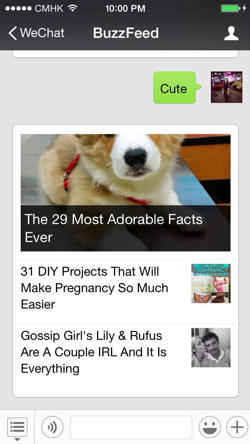
4) Line
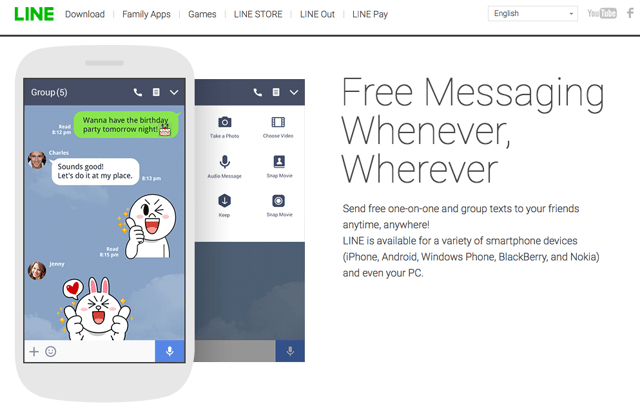
Monthly active users: 217 million
Most popular regions: Japan, Thailand, Taiwan, and Indonesia
Age group: 10-49
Marketing Features:
Line is a free messaging app that offers a profile page, stickers, games, video calling, music streaming, ride-sharing, and about 30 other features. It dominates Japan’s messaging app market, where 94% of messaging app users use the app.
Line is chock full of opportunity for marketers. In its four most popular countries, 73% of monthly active users use the app every day. This abundance of user engagement allows brands to build huge followings and boost engagement rates.
In fact, the Wall Street Journal acquired 2 million Line followers in only 15 months, which is the fastest social channel growth they’ve ever seen. They also claim that 30% of its followers like, comment, and share all their posts.
When brands sign up for Line official accounts, they can:
- Set up a profile page
- Send chat messages to each of their subscribers
- Post content on their subscribers’ timelines
- Activate chatbots that deliver keyword-triggered responses and content
- Optimize Line advertisements based on user demographics and interests
- Distribute free branded stickers
- And reward customers with stickers after they buy a product
For Paul McCartney, Line is actually the best way to reach fans. His 12.5 million Line followers are more than all his Facebook, Twitter, and Instagram followers combined.
And since he can send private messages to each of his 12.5 million Line followers, he also engages with them a lot more than he can with his traditional social media following.
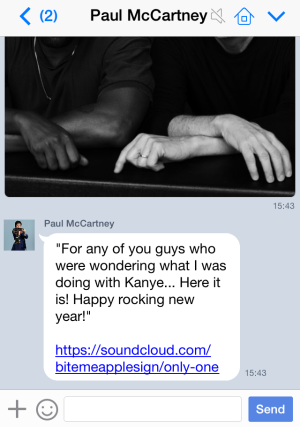
Photo Credit: TechCrunch
5) Slack
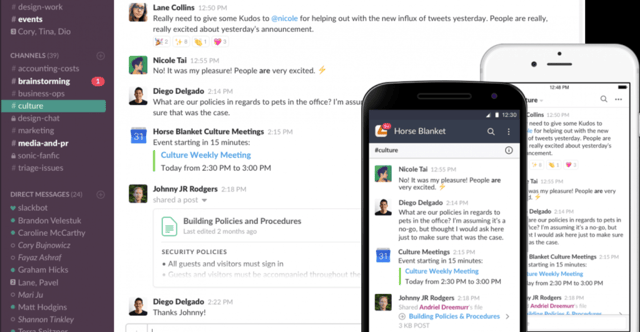
Daily active users: 5 million
Most popular regions: United States
Age group: 25-54
Marketing Features:
Slack is the main internal communications platform for many businesses. In fact, 77% of Fortune 100 companies use it. If you work in B2B, Slack could be your most targeted marketing channel.
At HubSpot, we knew Slack could be an effective content delivery channel, so we decided to offer a Slack blog subscription. When users sign up for it, they add the HubSpot Blog app to their Slack profile, where they receive a weekly broadcast of content. They can also search for content in the app.
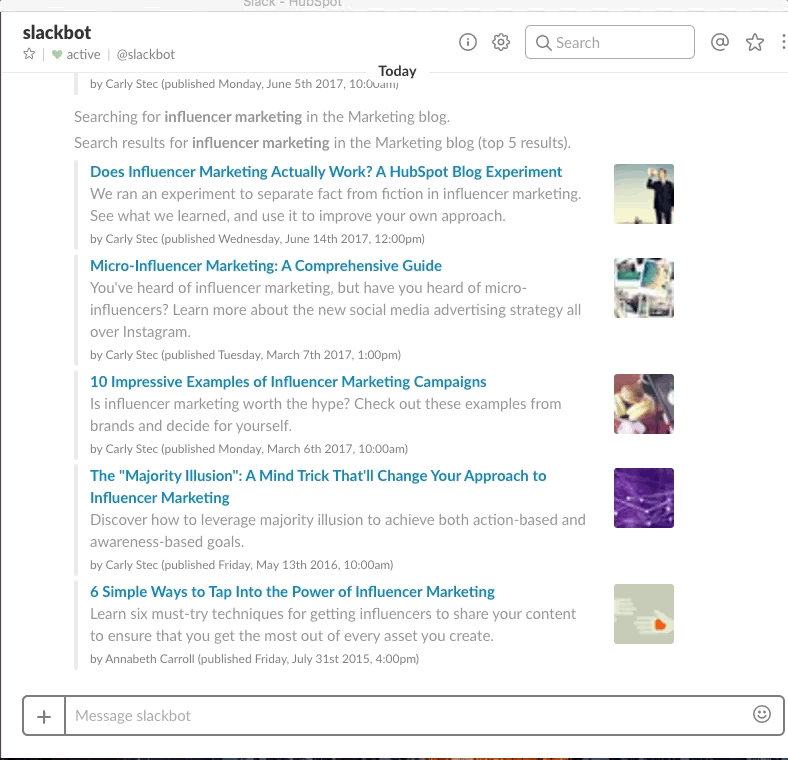
What messaging apps do you use for your marketing? Let us know on Twitter!
from Marketing https://blog.hubspot.com/marketing/best-messaging-apps-for-marketing



No comments:
Post a Comment